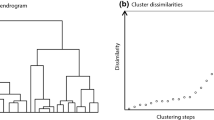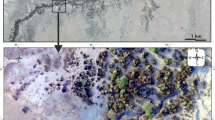Abstract
We define a distance between sedimentary successions to compare their dissimilarity formally. Distance definition is based on attributed syntactic representation. One-dimensional successions can be represented by a string of lithofacies symbols sequentially or vertically. Each symbol can also have a vector of attributes that can provide other information on lithofacies such as thickness. The distance of any two successions is then defined consisting of its syntactic and attribute subdistances. Syntactic distance measures difference of vertical lithofacies change between two successions and attribute distance measures difference of thickness of corresponding lithofacies. Clustering is used to test validity of distance definition and its potential application to analysis of cycle-dominated sedimentary successions. Example is from the Namurian-A succession in Kincardine basin, central Scotland. There are 56 cycles in intervals of about 300 m each in two boreholes. Recognition of intermediate cycles depends on correctly determining of types of these short cycles and their vertical stacking pattern. Intermediate cycles have better potential in high-resolution stratal correlation regionally. Syntactic clustering results show that 56 short cycles can be classified into four groups with distinctive geological interpretation, which further helps reveal hierarchical cyclic architecture of the whole succession.
Similar content being viewed by others
REFERENCES
Bornholdt, S., Nordlund, U., and Westphal, H., 1999, Inverse stratigraphic modeling using genetic algorithms, in Harbaugh, J.W., Watney, W. L., and others, eds., Numerical experiments in stratigraphy: Recent advances in stratigraphic and sedimentologic computer simulations: SEPM Special Publication No. 62, p. 85–90.
Bunke, H., 1993, Advances in structural and syntactic pattern recognition:World Scientific, Singapore, 636 p.
Bunke, H., and Csirik, J., 1995, Parametric string edit distance and its application to pattern recognition: IEEE Trans. SMC, v. 25, no. 1, p. 202–206.
Cant, D. J., and Walker, R. G., 1976, Development of a braided-fluvial facies model for the Devonian Battery Point Sandstone, Quebec: Can. Jour. Earth Sci., v. 13, p. 102–119.
Chan, S. C., Wong, A. K. C., and Chiu, D. K. Y., 1992, A survey of multiple sequence comparison methods: Bull. Math. Biol., v. 54, no. 4, p. 565–598.
Coggins, J. M., 1983, Dissimilarity measures for clustering strings, in Sankoff, D., and Kruskal, J. B., eds., Time warps, string edits, and macromolecules: The theory and practice of sequence comparison: Addison-Wesley, p. 311–321.
Cross, T. A., and Lessenger, M. A., 1999, Construction and application of a stratigraphic model, in Harbaugh, J. W., Watney, W. L., and others, eds., Numerical experiments in stratigraphy: Recent advances in stratigraphic and sedimentologic computer simulations: SEPM Special Publication No. 62, p. 69–84.
Duan, T., Griffiths, C. M., and Johnsen, S. O., 1996, Syntactic simulation of 1-D sedimentary sequences in coal-bearing succession by using stochastic context-free grammars: Jour. Sedimentary Research, v. 66, p. 1091–1101.
Duan, T., Griffiths, C. M., Cross, T. A., and Lessenger, M. A., 1998, Adaptive stratigraphic forward modeling: Make forward modeling adaptive to conditional dataset: Abstracts, AAPG Annual Conference in Salt Lake City, Utah, p. 169.
Duan, T., Griffiths, C. M., and Johnsen, S. O., 1999, Conditional simulation of 2-D parasequences in shallow marine depositional systems by using attributed controlled grammar: Computers & Geosciences, p. 667–681.
Dubes, R. C., 1993, Cluster analysis and related issues, in Chen, C. H., Pau, L. F., and Wang, P. S. P., eds., Handbook of pattern recognition and computer vision:World Scientific, Singapore, p. 1–32.
Fu, K. S., 1982, Syntactic pattern recognition and applications: Prentice-Hall, Englewood Cliffs, NJ, 596 p.
Fu, K. S., 1986, A step towards unification of syntactic and statistical pattern recognition: IEEE Trans. Pattern Anal. Machine Intell., v. PAMI-8, p. 398–404 (reprinted from 1983 original).
Griffiths, C. M., 1990a, Choice of lithology identifiers for modelling purposes in quantitative stratigraphy—A role for petrophysics in stratigraphy, in Cross, T. A., ed., Quantitative dynamic stratigraphy: Prentice-Hall, Englewood Cliffs, NJ, p. 67–85.
Griffiths, C. M., 1990b, The language of rocks—An example of the use of syntactic analysis in the interpretation of sedimentary environments from wireline logs, in Hurst, A., Lovell, M. A., and Morton, A. C., eds., Geological application of wireline logs: Geological Society of London, Special Publication 48, p. 77–94.
Kaufman, L., and Rousseeuw, P. J., 1990, Finding groups in data: An introduction to cluster analysis: Wiley, New York, p. 342.
Knuth, D. E., 1968, Semantics of context-free languages: Jour. Math. System Theory, v. 2, p. 127–146.
Levenshtein, V. I., 1966, Binary codes capable of correcting deletions, insertions and reversals: Cybernetics and Control Theory, v. 10, no. 8, p. 707–710.
Lu, S. Y., and Fu, K. S., 1978, A sentence-to-sentence clustering procedure for pattern analysis: IEEE Trans. SMC-8, no. 5, p. 381–389.
Read, W. A., 1994, High-frequency, glacial-eustatic sequences in early Namurian coal-bearing fluviodeltaic deposits, central Scotland, in De Boer, P. L., and Smith, D. G., eds., Orbital forcing and cyclic sequences: IAS Special Publications No. 19, p. 413–428.
Read, W. A., and Forsyth, I. H., 1989, Allocycles and autocycles in the Upper part of the Limestone Coal Group (Pendleian, E1) in the Glasgow-Stirling Region of the Midland Valley of Scotland: Geol. Jour., v. 24, p. 121–137.
Wagner, R. A., and Fisher,M. J., 1974, The string-to-string correction problem: Jour. Assoc. Computer Machinary, v. 21, no. 1, p. 168–173.
Author information
Authors and Affiliations
Rights and permissions
About this article
Cite this article
Duan, T., Griffiths, C.M. & Johnsen, S.O. High-Frequency Sequence Stratigraphy Using Syntactic Methods and Clustering Applied to the Upper Limestone Coal Group (Pendleian, E1) of the Kincardine Basin, United Kingdom. Mathematical Geology 33, 825–844 (2001). https://doi.org/10.1023/A:1010950814715
Issue Date:
DOI: https://doi.org/10.1023/A:1010950814715




